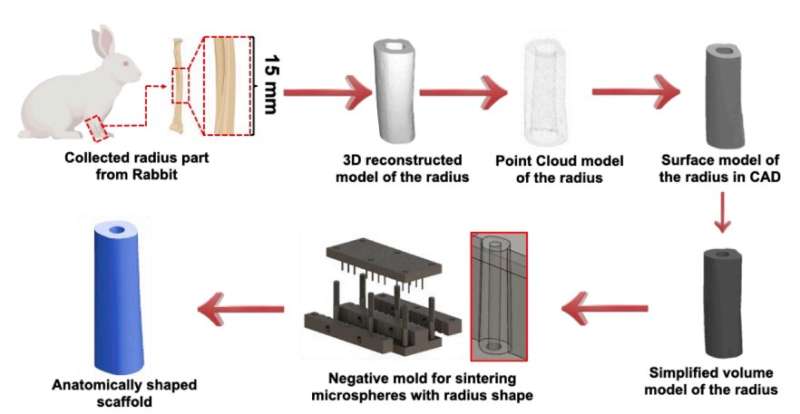This article has been reviewed according to Science X's editorial process and policies. Editors have highlighted the following attributes while ensuring the content's credibility:
fact-checked
peer-reviewed publication
trusted source
proofread
New method can promote regrowth of long bones more affordably and with fewer side effects

Repairing severely damaged bones is a challenge—especially the long bones of the arms and legs. Now, UConn Health scientists describe a new method in the May 22 issue of the Proceedings of the National Academy of Sciences that can promote regrowth of long bones more affordably and with fewer side effects than other techniques.
Cleanly broken bones often heal without problems. But bones with smashed or missing sections are much more difficult to regenerate. Grafting across the gaps using bone from elsewhere is one way to fix them, and about 500,000 bone grafts are done in the U.S. every year. But bone grafts alone don't always work, and they're quite costly. Recently, orthopedic surgeons have begun treating difficult breaks with specific human proteins that encourage bone growth, both alone and paired with grafts or scaffolds. They are used to encourage bone regrowth in spinal fusion surgeries, for example.
But the proteins, known more specifically as recombinant human bone morphogenetic proteins (rhBMPs), have limitations. First is that large molecules such as rhBMPs can be expensive to manufacture and store. Another is that the immune system has a tendency to treat them as invaders to be neutralized, limiting their usefulness. And rhBMP treatments have been known to induce bone growth in undesirable locations in addition to the site of the bone fracture.
University Professor Dr. Cato T. Laurencin and colleagues at UConn School of Medicine used a slightly different approach to encourage bone growth. They wanted to release a medicine directly where new bone needed to grow, and do it in a short period of time. So they built a scaffold out of a biodegradable polymer to guide the growth of the new bone. They impregnated the scaffold with forskolin, a small molecule that encourages the same bone growth response as rhBMPs do. And guessing that some of the undesirable effects from rhBMPs were related to long-term use, they engineered the scaffold to release the forskolin almost entirely within a 24 hour period.
They then tested two forskolin-impregnated scaffolds (one high dose, one low dose) against a scaffold impregnated with rhBMP, and a control scaffold that had no bone growth factor added. The scaffolds were applied to rabbits who had serious broken bones in their forelimbs.
The researchers found that the high dose forskolin-impregnated scaffold and the rhBMP-impregnated scaffolds did equally well at encouraging new bone growth in the rabbits' forelimbs. Both were much better than the control or the low-dose forskolin. The short, 24-hour duration of the drug release also seemed to prevent the unwanted side effects often seen in rhBMP treatment.
Although the forskolin scaffold and rhBMP scaffolds performed equally well at encouraging new bone growth and repair, forskolin has certain advantages. It's a small molecule that is more stable, easier to manufacture, lower in cost, and unlikely to incite an immune system reaction.
"I am delighted to see the outstanding progress of the field of regenerative engineering leveraging cutting-edge technology to apply to broad fields. The potential of polymeric chemistry and novel biological materials in combination offer new potential to tackle complex societal problems in tissue regeneration. The work presented here is an important example," says Laurencin, the Albert and Wilda Van Dusen Distinguished Endowed Professor of Orthopaedic Surgery at UConn and CEO of The Cato T. Laurencin Institute for Regenerative Engineering at UConn.
Future studies will examine forskolin's bone growth effect in more detail, evaluating forskolin's movement and interactions in the body and how it interacts with the body's stem cells in more detail.
More information: Guleid M. Awale et al, Regenerative engineering of long bones using the small molecule forskolin, Proceedings of the National Academy of Sciences (2023). DOI: 10.1073/pnas.2219756120



















